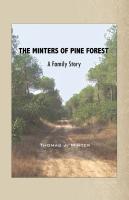| ||||||||||||
| Category: History |
(requires Adobe Reader)
|
| About the Book | |
|
A story about a line of people who have traces going back to Wales. It follows the families from the early 1600’s in the Colony of Virginia, when they were under British dominion, to Chatham County North, Carolina, in 1752, where they put down roots and created plantations, and later supported materially and fought with the Rebels during the American Revolution. By 1817, most of the family members had either died in Chatham County or moved to other states. John Morgan, the patriarch of the Pine Forest Minters, moved to Georgia, as did his brother Abner Hill, where in Putnam County he married Dolly Mathis, the daughter of a Revolutionary soldier and plantation owner, and settled down to raise his own family of four boys and one girl. In addition to farming he served in the Georgia Legislature both as a Representative and as a Senator. Later the family moved to Marion County, Georgia, where Dolly died and was buried in the Buena Vista, Geogia, city cemetery. The book goes on to chronicle John Morgan and his family’s migration from Georgia to the frontier in Hopkins County, Texas, in 1855. It relates in some detail how the Minters helped found the town of Pine Forest, which was first called Saratoga, and how the families increased and thrived and made their individual contributions in developing the area. Some family members were particularly adept at building and operating grist mills and cotton gins. In more modern times a couple of family members were even bit movie actors. One family member is dubbed the storyteller of Pine Forest. The Minters service in the Confederacy in the Civil War, with one family member raising a company of soldiers for the conflict, and their service in World War I is also part of the story. And the narrative gives the details of the families’ ownership of slaves, and their relationship to them before and after the Emancipation Proclamation of 1863. Throughout the book this story is told in the context of how the families lived their lives—their occupations, tragedies, births, deaths, recreation, and the times in which they lived. Now in its 20th American generation, one learns how the descendants of this family are ingrained with what Frederick Jackson Turner called the “uniquely American character” in his frontier thesis "The Significance of the Frontier in American History" (1893). This bent of character is manifested in part as to how one is hospitable to strangers, distrustful of authority, more individualistic, and has reverence for all womankind. As to the to the latter, some readers can, for example, identify with the notion that if you want to get into deep trouble real fast, just sass your momma or some other woman. This story, which ends with the advent of the Great Depression in 1929 where many families and members were dispersed due to economic hard times, is helped in the telling with ancestral charts, DNA information, and over 125 pictures and illustrations.
|
|
| About the Author | |
 |
Tom Minter spent his boyhood in the wider Pine Forest area at Saltillo, and has trod the lands of his ancestors, and knows them well. Now retired as Professor Emeritus of Engineering at the University of Toledo, he and his wife enjoy visiting Civil War Battlefields and other historical sites. |

